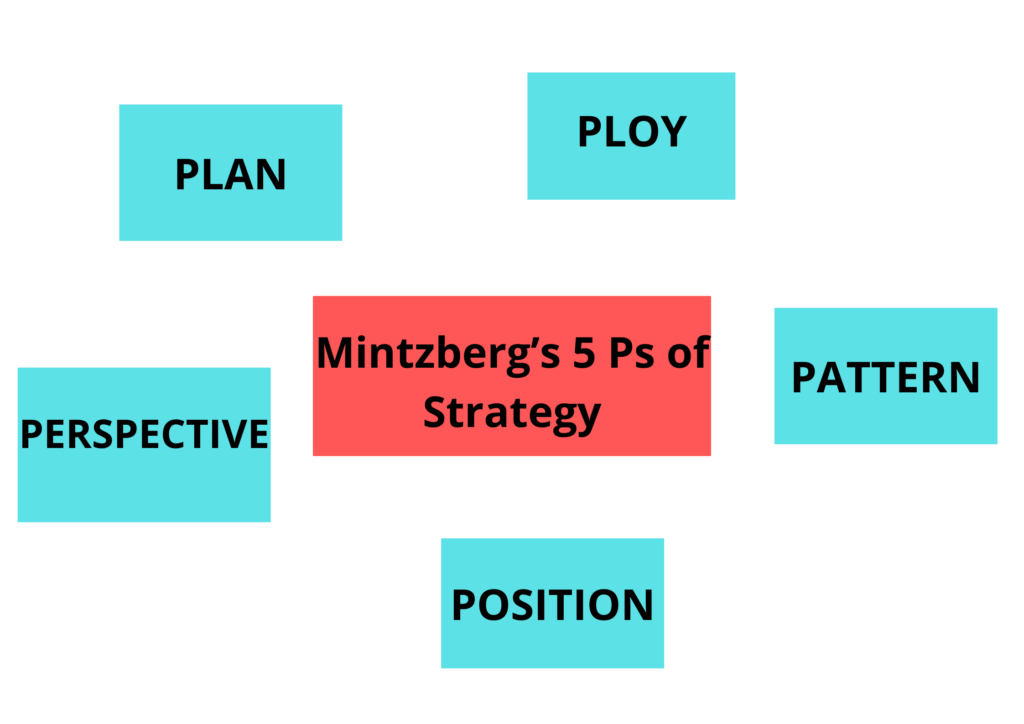Mintzberg’s 5Ps of strategy is a model that is introduced by Henry Mintzberg as a model that can help the business to develop its business strategy by examining from five different perspectives. Since building and implementing the best possible business strategies are highly important for the success of the business taking all the relatable aspects into consideration is advantageous for the business.
Management expert Henry Mintzberg has explained that is extremely difficult for businesses to get the strategy right. He introduced Mintzberg’s 5Ps of Strategy in 1987 as a solution that will help the businesses to build the most successful business strategy.
Most business organizations take a simplistic approach when developing their business strategies. Many businesses use analysis methods such as SWOT or PESTEL to analyze the business’s internal and external environment and develop the business strategies merely based on these analyses.
Unfortunately, developing the business strategies just by analyzing the business environment is highly unlikely to give favorable results for the business development and success. The managers should invest some time and effort to understand the business, possibilities, risks, and what exactly they want to achieve and get the management strategy right.
Even if the management is capable of getting the strategies right, it can be threatened overnight by unpredictable changes in the business environment. For this reason, the business strategies should be flexible in order to face the changes successfully.
In Mintzberg’s 5Ps of strategy, each ‘P’ explains what strategy means from a different perspective. The purpose of this is to develop a more robust strategy than building it by just looking at strategy from one perspective.
The five approaches in Mintzberg’s 5Ps of strategy are,
1. Plan
2. Ploy
3. Pattern
4. Position
5. Perspective
01. Plan
It is essential for a good strategy to have a properly created plan. A course of action the business is intending to implement in the business and the guidelines the business is planning to follow when implementing the strategy should be included in the plan.
The purpose of building a plan is to identify the current status of the business and define where the business wants to be. It should define what exactly the business is planning to achieve. The tools such as SWOT analysis and PESTEL analysis can be used as tools when developing the plan for the business. Apart from that, change management and project management techniques are highly important in building a successful plan.
All plans have two main characteristics.
– Plans are developed with a purpose
– Plans are developed in advance
Even though planning is essential for a successful strategy, planning itself is not sufficient for a good strategy. This is the reason to concentrate on other Ps in Mintzberg’s 5Ps of strategy.
02. Ploy
According to Mintzberg, getting better than competitors by planning to disrupt and discourage them or by making an influence on them is considered as a part of building a good strategy. This is a way of getting better than the product competitors. In usual business situations, it is impossible to avoid competitors in a market. Ploys are specific tactics a business can use to disrupt or influence competitor activities.
Below mentioned are examples of ploys that can be used by a business.
– Obtaining patents and trademark rights
– Reducing prices to discourage competitors
– Investing in areas of excellence such as consumer support
– Legal actions
There are several tools that a business can use to develop ploys.
– scenario planning
– futures wheel
– impact analysis
– game theory
Ploys are considered as short-term techniques to create an impact on the competitors.
03. Pattern
The business needs to look at their own behavior as the output from the strategy doesn’t come only from plan and ploy. This makes it important for the business to put more consideration on the day-to-day tasks they perform in the business functions.
Pattern in Mintzberg’s 5Ps of strategy is about concentrating on what kind of behavior patterns have worked for the business in the past and deciding which of those patterns needs to be continued or enhanced for future success.
04. Position is another approach to defining the strategy. Position explains where the business is currently in the market and compared to the competitors in the same market.
Below mentioned are the example positions.
– Having the highest number of features
– Offering the cheapest price
– Providing benefits to a particular customer niche
– Having the best customer support services
Position helps the business to identify how they are planning to get more customers attracted to the product from the target market. The business has to identify the advantages and disadvantages while building the position and work to use advantages and eliminate disadvantages.
05. Perspective
Perspective concentrates on shaping the culture and the personality of the business organization. The perspective of the business will be set from how they view the marketplace what the business perceives it wants. Just like the patterns of organizational behavior can emerge as a strategy, a pattern of thinking will help the organization to build a perspective.
Cultural analysis tools such as Deal and Kennedy’s Cultural Model, Cultural Web, and Congruence Model can be used to get a perspective on the business.

